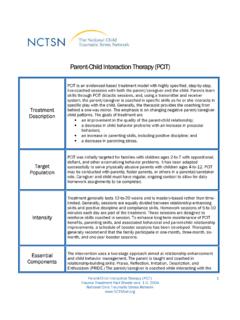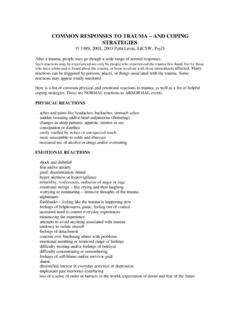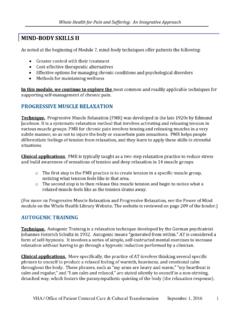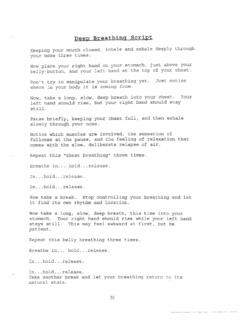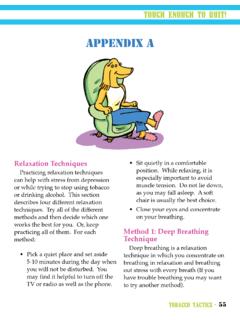Transcription of Relaxation and Relaxation Exercises
1 This resource guide was produced at the Trauma Center, with the funding of the Massachusetts Office for Victim Assistance (MOVA), under afederal Anti-Terrorism Supplemental Grant (ATSG), to aid Victims of and Responders to the 9/11 Terrorist Attacks. It is not intended tosupplant professional and Relaxation ExercisesWhen we are under stress the body goes into survival mode. It produces stress hormones, which gear usup to respond to perceived danger. This has come to be known as the fight or flight response. In thatstate, the heart rate increases, respiration becomes rapid and shallow, there is a rise in blood pressure,and the brain itself moves into a primitive survival mode, suppressing normal thought functions(evaluation, planning, deciding, encoding memory normally, etc.)
2 The result of this is that we react ratherthan being able to evaluate and plan a response to the stressor. Under certain circumstances, the bodymay be in a constant state of fight or flight, which is exhausting and can contribute to the developmentof physical stress-related disorders, such as cardiac problems, chronic high blood pressure, andincreased risk of for relaxationFind a quiet space where you won t be interrupted for at least 30 minutes. Turn the lights down if you s helpful to wear loose, comfortable clothing. If there is unavoidable noise, it may help to put on somebackground music or a tape of natural sounds.
3 Turn off the phone and give yourself permission to devotesome time to may sit or lie down for Relaxation . If you sit in a chair, it s preferable to have your spine straight andsupported by the chair back. If you lie down, you may want your back flat, and legs straight. It spreferable to have your legs uncrossed, extended, so you can feel the flow of energy. These are all justsuggestions, however; the most important thing is that you feel comfortable and free to position yourselfas you shows that relaxing the body will relax the mind, and vice versa. If you struggle with racing,obsessive or intrusive thoughts, it might help to focus on the body.
4 If you have a lot of physical tension orpain, it may be better to work on relaxing the mind. It s hard to predict which exercise will work for whom;it s best to try different Relaxation Exercises until you find the one that feels right. Remember that you arepracticing a skill like playing the piano. The more you practice, the more effective your Relaxation is important to work toward an attitude of acceptance of whatever occurs in your session, rather thangrowing impatient if you don t achieve a given result. You are just exploring the sensations or images youchoose to focus on, and noticing what happens physically, emotionally and mentally.
5 This mindful approach will pay off, and you will eventually be able to experience a state shift that is a deep, peacefulstate of Relaxation . As you get better and better at the mindful self-observation, you will be able to use itall the time, to notice what is going on in your body, to notice your emotions, and to pay attention to thethoughts that may be contributing to your emotional is helpful to start out each Relaxation exercise by doing a simple check in of your emotional state, yourthoughts, and what you are feeling in your body. Just notice what is happening, without judgment resource guide was produced at the Trauma Center, with the funding of the Massachusetts Office for Victim Assistance (MOVA), under afederal Anti-Terrorism Supplemental Grant (ATSG), to aid Victims of and Responders to the 9/11 Terrorist Attacks.
6 It is not intended tosupplant professional Muscle RelaxationThis exercise involves systematically tensing and relaxing different muscle groups. This is a goodrelaxation exercise for those who have trouble concentrating, or experience racing thoughts or othermental distractions. You may leave your eyes open or close them, as you prefer. Experiment with howmuch you tense your target muscles: some find tensing tightly is most helpful, while others use thresholdtensing, just tightening enough to barely sense the out by taking a few deep breaths into the abdomen. Just notice the a simple check-in of your emotional state, your thoughts, and what you are feeling in your body.
7 Justnotice what is happening, without judgment or a fist with your right hand, and tense the muscles in your right forearm, allowing the rest of the armto remain the sensations of the tensed muscles to the relaxed ones in the opposite arm, and in the rest of the you re ready, take a deep breath in, and, as you exhale, slowly, gradually release all of the tension,until every last bit has left the tensed muscles. You may imagine it s like a fire hose that was rigid andbecomes more flexible as the water drains out, or a any image that works for a few moments studying and appreciating the sensations in the muscles once they are this with your left fist and your right shoulder, pin your right upper arm to the side of your body, and tense the muscles in theright upper arm and the sensations of the tensed muscles to the relaxed ones in the opposite arm, and in the rest of the you re ready, take a deep breath in, and, as you exhale, slowly, gradually release all of the tension.
8 Until every last bit has left the tensed muscles. Find an image that captures this gradual release of tensionfor you: the sun melting ice, butter melting, releasing pressure with a valve, et a few moments studying and appreciating the sensations in the muscles once they are this with your left upper arm and your leg extended, bend your right foot up at an angle, so the muscles of your right calf, shin, ankleand foot are tensed. Allow the rest of the leg to remain the sensations of the tensed muscles to the relaxed ones in the rest of the leg, and in the rest of the you re ready, take a deep breath in, and, as you exhale, slowly, gradually release all of the tension,until every last bit has left the tensed muscles.
9 You may imagine it s like a fire hose that was rigid andbecomes more flexible as the water drains a few moments studying and appreciating the sensations in the muscles once they are this with your left foot and lower the muscles in the right buttock and thigh, allowing the remaining muscles in the right leg to remainas relaxed as the sensations of the tensed muscles to the relaxed ones in the opposite buttock and thigh, and in the rest of you re ready, take a deep breath in, and, as you exhale, slowly, gradually release all of the tension,until every last bit has left the tensed resource guide was produced at the Trauma Center, with the funding of the Massachusetts Office for Victim Assistance (MOVA), under afederal Anti-Terrorism Supplemental Grant (ATSG), to aid Victims of and Responders to the 9/11 Terrorist Attacks.
10 It is not intended tosupplant professional a few moments studying and appreciating the sensations in the muscles once they are this on the left in your abdominal muscles, and simultaneously push the small of your back against the chair orfloor. Study the sensations of the tensed muscles to the relaxed ones in the rest of your you re ready, take a deep breath in, and, as you exhale, slowly, gradually release all of the tension,until every last bit has left the tensed a few moments studying and appreciating the sensations in the muscles once they are your head fall forward, or, alternatively, press your head backward against a wall, to tense themuscles in the back of your the sensations of the tensed muscles to the relaxed ones in the rest of your you re ready, take a deep breath in, and, as you exhale, slowly.
